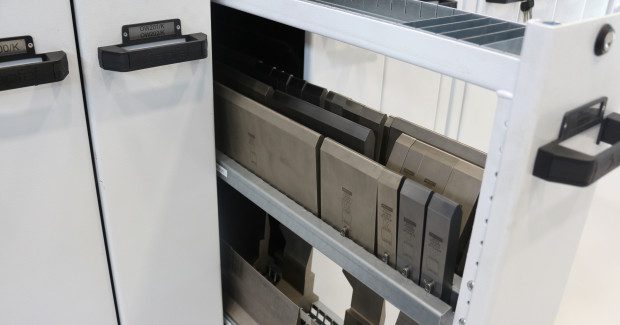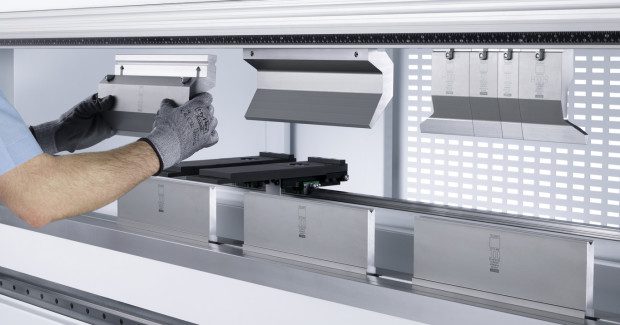A Little TLC Means a Lot to Press Brake Tooling
Press brake tools are the only parts of the machine that ever touch the finished parts being formed. The best precision CNC press brake cannot produce good products with poor tooling, and bad tooling makes all the good hardware in the process – including the machine operator – useless.
Posted: February 2, 2016
The importance of tooling to the press brake forming process can never be overstated. Tooling is to the press brake what tires are to a race car. Even with the most powerful engine, the strongest powertrain, the best balanced chassis, and the flattest suspension, that race car will not win without excellent tires to match. The tires are the only part of the car that ever touch the race track. They handle all of the acceleration, braking power and steering of the car. Without them, the rest of the vehicle’s hardware (driver included) become useless and the car becomes unmanageable. Like the tires on the race car, press brake tools are the only parts of the machine that ever touch the finished products being formed. The best precision CNC press brake cannot produce good products with poor tooling and bad tooling makes all the good hardware in the process (including the machine operator) useless.
Accepting that good press brake tooling is a basic necessity to manufacture good products, it makes sense to maintain the tooling that keeps the whole process running productively. To keep a car operating at peak performance tires must be rotated, balanced, and replaced when excessively worn. Likewise, there are basic steps any manufacturer can take to extend the productive life of press brake tooling. In addition, all personnel responsible for handling the tools should be aware of some basic best practices as well as warning signs which indicate when tooling is excessively worn and should be replaced.
LUBRICATION
Press brake tooling shares a trait with the press brake machine itself: proper maintenance begins and ends with lubrication and cleanliness. Press brake tools should, as often as possible, be coated in a film of light oil. Acids from the environment, like the ones found in the naturally-occurring oils on your hands, as well as oxygen and water vapor corrode metal parts. Keeping tools coated in a light oil protects from this corrosion –while in the machine as well as in the storage rack. During operation, the light film of oil will inhibit friction between the part being formed and the tools, reducing the wear on the tools and extending their life. This reduction in friction decreases the pressure required to form a bend. For high-tonnage applications, this difference can bring a bend that your press brake just barely cannot finish to one that is within its capacity. When bending heavier plates, try applying a thick layer of a heavy-weight oil such as STP to the tooling. This simple action could reduce the force required to bend to 90 deg by as much as 5 percent to 10 percent.
https://youtu.be/2HUWB87S4Yc
TOOL CLEANLINESS
Lubrication and cleanliness becomes especially important in certain applications, in particular when the material being formed has a tendency to foul or gall the tooling. Fouling might occur, for example, when forming hot-rolled steel with heavy scale on the surface, or any mild steel part that has been laser-cut using oxygen assist gas or an oxy-fuel cutting process. These parts leave metal flakes on the tooling and machine during the bending process. Those metal flakes cause excessive abrasion which can rapidly damage tooling and machine alike. Periodically wiping down the tools (and machine) with an oiled rag to remove metal flakes is about the most important thing anyone can do to prevent undue wear and tear.
Galling occurs when a very soft material, such as aluminum or vinyl, leaves traces of the material behind during the forming process. For example, plastic-coated stainless steel will leave a residue of plastic and glue. The worst offenders are the softest and gummiest grades of aluminum, which will rapidly leave a layer of aluminum on the working edges of your tools. Oil helps to reduce the initial build-up but once it has occurred, the best way to remove it is to buff the working edges of the tools (shoulders for the lower dies, tip radius for the upper tools) with a mild abrasive pad such as Scotch-Brite. This kind of abrasive won’t harm hardened press brake tools, but it will remove all but the most hardened residue that accumulates on the tooling. Run over the tools with an abrasive pad periodically during production to prevent a major chore later on.
Of course working with well-oiled tooling poses a potential hazard if not handled with care. Tooling with oil on it will be slippery and an operator must be able to safely load and remove tools from the machine, as well as into and out of storage. In general, machine operators should always wear work gloves when operating machinery or handling tooling –oiled or not. A good rule of thumb for safe handling of oiled tooling with work gloves is to always grip the tooling sections with both hands, regardless of whether the weight deems it necessary. Use one hand only if a tool segment is small enough to wrap your fingers around it.
INDICATORS OF WORN OUT TOOLING
When tooling has become worn beyond usefulness, there are obvious indicators. When the tools are clamped inside the press brake, look for sections that are visibly misaligned at the edges. Mark the misaligned places, move the tool sections around, and then check again. This will help determine if a section of tooling is damaged or if there is a problem with the tool clamping on the machine. Another visual indicator of wear is deep scrape marks across the punch radius or die shoulders. Scrape marks deep enough that you can feel them with your thumb indicate the hardened material of the tool has been compromised, and that can mean bad bending angles on finished parts.
Keep press brake tooling oiled, clean and free from metal dust and galling, and pull worn tools from production. By sticking to these guidelines for maintaining your press brake tooling, your forming operations will remain accurate and you will ensure the quality of the finished goods downstream. Ultimately, that means winning the race.








